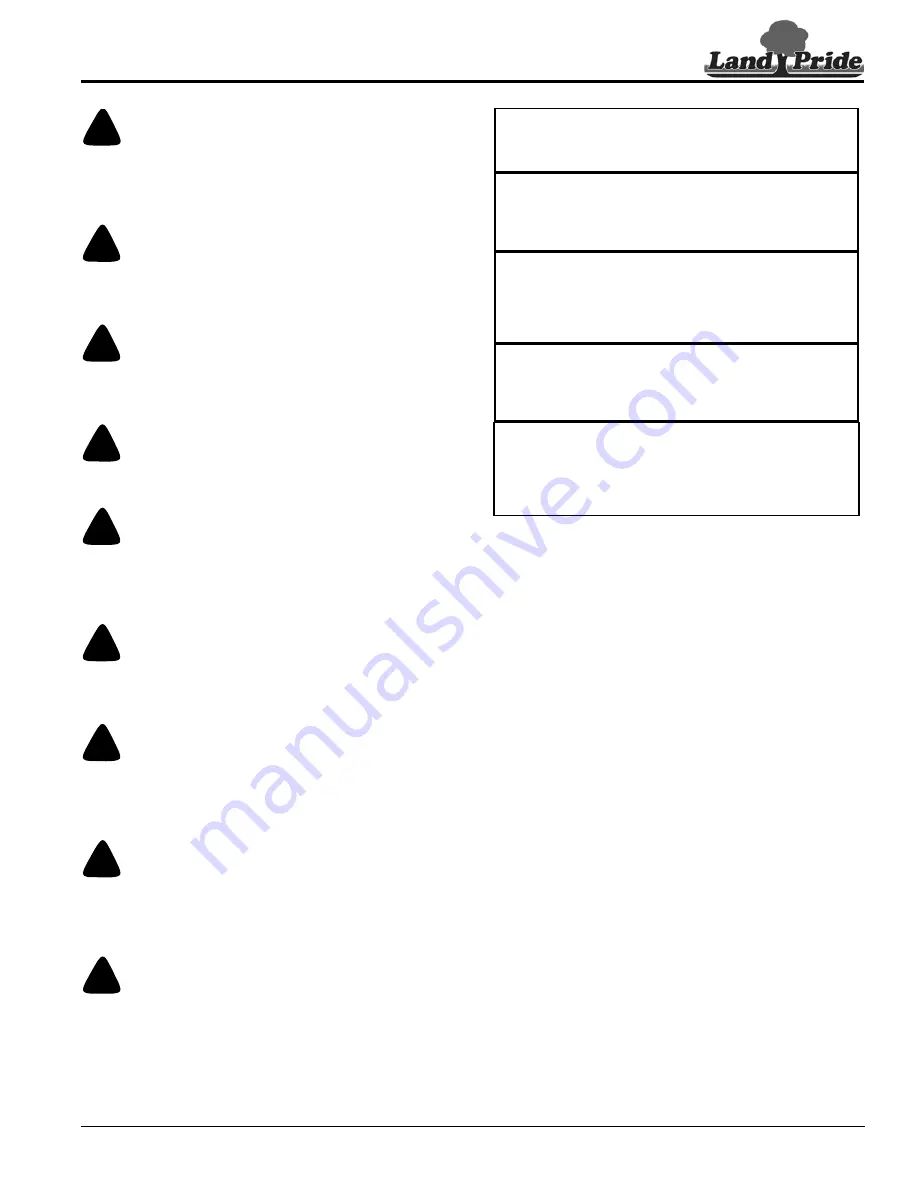
23
Section 3: Operating Instructions
4/20/15
RC3615 (540 RPM) and RCM3615 (1000 RPM) Rotary Cutters 330-502M
Table of Contents
!
DANGER
Clear area to be cut of debris and other unforeseen removable
objects before cutting. Mark any potential hazards that cannot
be removed such as tree stumps, posts, large rocks, holes, and
drop-offs with a visible flag.
!
WARNING
Always disengage PTO, place tractor in park or set park
brake, shut tractor engine off, remove switch key, and wait for
blades to stop before dismounting from tractor.
!
WARNING
Keep blade bolt access hole covered at all times except when
servicing cutter blades. Make sure driveline is disconnected
from tractor PTO shaft before servicing cutter blades.
!
WARNING
Do not use cutter to tow other equipment. Doing so can
damage the cutter, cause serious bodily injury or death.
!
WARNING
Do not raise wings up with PTO engaged and drivelines
rotating. Objects can be thrown by the rotating blades and
driveline yokes can break as the wings are raised. Always keep
people away from a cutter that is operating.
!
WARNING
Do not operate cutter with loose pins, bolts, or nuts. Loose
hardware can result in a serious breakdown causing bodily
injury or death.
!
WARNING
Do not operate cutter with a hitch or hitch pin that is
excessively worn, has structural cracks, is bent, or is broken.
The hitch and/or hitch pin can break apart separating cutter
from tractor causing serious injury or death.
!
CAUTION
Do not exceed the rated cutting capacity. See Specifications &
Capacities for specified cutting capacity. Using this cutter for
any other type of work can damage drive components, cutter
blades and deck components.
!
CAUTION
Do not over speed PTO or machine damage may result. Many
tractors provide both 540 and 1,000 RPM PTO speeds. Check
your tractor’s manual to determine its capabilities.
• RC series cutters are designed for 540 RPM rear PTO.
• RCM series cutters are designed for 1000 RPM rear PTO.
Tractor & Cutter Inspection
Make the following inspections with cutter attached to a
tractor and cutter parked on a level surface, PTO
disengaged, and cutter blades stopped.
1.
Inspect tractor safety equipment to make sure it is in
good working condition.
2.
Inspect cutter safety equipment to make sure it is
installed and in good working condition.
3.
Check driveline to make certain it is securely
connected to the tractor PTO shaft and cutter
gearbox shaft. Also, make certain that the guards are
in good working condition and in place.
4.
Carefully raise and lower implement to ensure that
the drawbar, tires, and other equipment on the tractor
do not contact cutter frame or driveline.
5.
Remove 3-point lower arms or secure them so they
do not interfere with driveline, hoses, or hitch.
6.
Check all hoses and wires to be sure that they will not
pinch or come in contact with rotating driveline.
7.
Raise center deck fully up and place sturdy support
blocks or parking jacks under the four deck corners.
Lower center deck down onto the supports.
8.
Place gear selector in park, shut tractor engine off,
remove switch key, and dismount from tractor.
9.
With cutter resting on solid supports, PTO
disengaged, and blade rotation completely stopped:
•
Check for and remove foreign objects wrapped
around blade spindles.
•
Check for nicked, bent, broken, and worn cutting
blades. Replace or sharpen blades as required.
Refer to
“Cutter Blade Maintenance”
on page 32.
IMPORTANT:
Avoid catching hydraulic hoses on
brush, posts, stumps, and other protrusions that
could damage and/or break them.
IMPORTANT:
Maintain correct PTO speed. Loss of
PTO speed will allow blades to swing back and result
in ragged, uneven cutting. Excessive speed will
cause damage to the power train components.
IMPORTANT:
If wing driveline profile is bent or
twisted, disconnect that driveline from the wing
gearbox before folding the wing up. This will protect
both the wing and divider gearbox. Repair driveline
before putting cutter back into service.
IMPORTANT:
This Rotary Cutter is equipped with
free swinging cutting blades to reduce shock loads.
However, it is best to avoid striking obstacles for your
safety and to protect the cutter from damage.
IMPORTANT:
Watch while making tight turns to
ensure that the rear tractor tires and lower 3-point
arms do not make contact with cutter hitch, driveline
or deck. Keep lower 3-point arms raised at all times
when hitched to a pull-type cutter.

















































